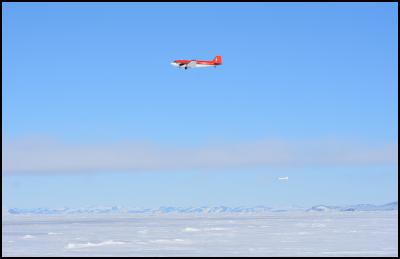Icetronauts use old bird to measure Antarctic ice
Icetronauts use old bird to measure Antarctic ice

Towed below a DC3 aircraft,
the state-of-the-art EM-bird flies 15 metres above Antarctic
sea ice. (Photo credit: P. Langhorne)
University of Canterbury glaciologist Dr Wolfgang Rack is leading the world’s first EM-bird measurement of sea-ice thickness, towed by a 75-year-old fixed-wing aircraft in McMurdo Sound, Antarctica.
Our aim is to explore how much sea water is freezing in the Southern ocean every year and how important it is to the global climate, Dr Rack says.
“Sea-ice thickness is the biggest unknown in cryosphere research, because it is so hard to measure. It amazes me how little we know about it, despite its significance for global climate,” he says. “The EM-bird is the only instrument which can measure the thickness of sea ice remotely.”
The 'EM' stands for ElectroMagnetic induction. It is a state-of-the-art technology to remotely measure ice thickness, and it works similar to an induction cook top, Dr Rack says.
“Because sea ice is salty, conventional radar cannot measure thickness, but the EM instrument can, although it needs to be operated close to the surface.”
For the measurements, the research team, called The Icetronauts, used a converted 1942-built DC-3 aeroplane to tow the EM-bird at a height of 15 metres above the Antarctic sea ice.
“We are happy to be the first researchers who have shown that the EM-bird can be operated in Antarctica safely from an aeroplane.”
Field measurements of sea-ice thickness and ocean properties were also made. The data is being used to verify aircraft and satellite measurements to derive ice thickness maps in the Southern Ocean, as part of a PhD study at Gateway Antarctica by UC student Gemma Brett.

University of Canterbury
doctoral student Gemma Brett in Antarctica (Photo
credit: University of Canterbury)
“For my PhD, I am using an instrument which is very similar to the EM-bird except it is ground-based – it is sled-mounted and I towed it behind a skidoo across the sea ice,” she says.
Dr Rack is a senior lecturer in Glaciology and Remote Sensing at Gateway Antarctica Centre for Antarctic Studies and Research, at the University of Canterbury. From November 2016 to January 2017 there were six icetronauts working on the ice; two on sea ice and four on the Ross Ice Shelf. There are currently eight icetronauts working at Gateway Antarctica.
“Sea-ice science requires a multidisciplinary approach as it involves glaciology, meteorology, oceanography, and biology,” Dr Rack says.
The Icetronauts project is being conducted as part of the New Zealand Government’s Deep South National Science Challenge for targeted observations of earth system variables. Project partners include NIWA, York University Toronto, the University of Otago and Antarctica New Zealand.


 Nōku Te Ao: Bringing Together Voices On Mental Distress, Stigma And Discrimination Under One Roof
Nōku Te Ao: Bringing Together Voices On Mental Distress, Stigma And Discrimination Under One Roof Office of Early Childhood Education: Early Childhood Education Sector Confidence Survey Results 2025
Office of Early Childhood Education: Early Childhood Education Sector Confidence Survey Results 2025 Bikesport NZ: Intrepid Kiwi Teen Ready To Accept New Challenge
Bikesport NZ: Intrepid Kiwi Teen Ready To Accept New Challenge Wellington Access Radio: Young People Take Over Wellington Access Radio For Youth Broadcasting Week 2025
Wellington Access Radio: Young People Take Over Wellington Access Radio For Youth Broadcasting Week 2025 Dental for All: Community Groups, Oral Health Professionals Welcome The Green Party's Re-Commitment To Free Dental Care
Dental for All: Community Groups, Oral Health Professionals Welcome The Green Party's Re-Commitment To Free Dental Care Wikimedia Aotearoa New Zealand: Christchurch Hosting A Weekend For Wikipedians
Wikimedia Aotearoa New Zealand: Christchurch Hosting A Weekend For Wikipedians